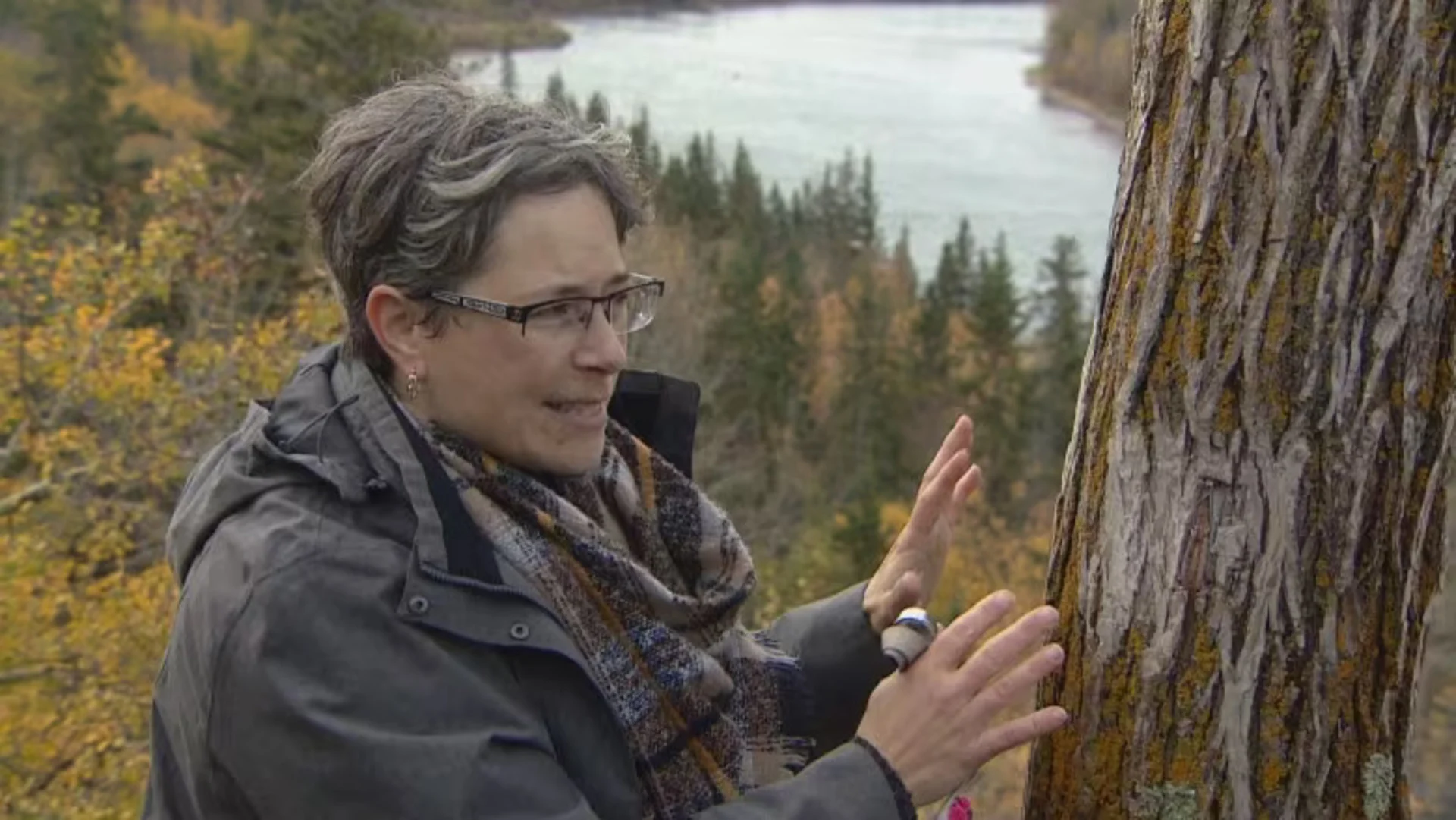
What lichens can tell us about climate and pollution
When you walk past a tree in Edmonton's river valley, you may notice tree trunks and branches are covered in multicoloured growths, decorating them in yellow, green, grey and bluish spots. These are lichens.
Lichens are fungi, not plants. They work closely with their photosynthesizing partner — usually algae — which live inside lichens.
Lichens are important determinants of air quality, said Troy McMullin, a lichenologist at the Canadian Museum of Nature in Ottawa.
"You can think of them as little sponges. They get their nutrients and minerals from what is floating by, what's in the air," he said.
"Essentially, they're eating the air and if there's pollutants in the air, they're going to eat those too."

Diane Haughland explains that three lichens are growing on this tree: the orange hooded sunburst, the grey shadow lichen, and the pale green speckled greenshields. This combination of lichens is typical of the exposed and dry location with decent air quality (Peter Evans/CBC)
Different lichens have different sensitivities to pollution and other environmental conditions, such as humidity.
There are tough and resilient lichens that can withstand some really challenging conditions, and then there are lichens that are more sensitive and require their environment to be more pristine.
If you know your lichens, you can look for them yourself and learn more about the environmental conditions in your area, McMullin said.
"You'd have to know specific species and you'd have to just go out and look for those," McMullin said.
SEE ALSO: Research finds mysterious fairy circles exist beyond Namibia and Australia
Diane Haughland, a lichenologist at the Alberta Biodiversity Monitoring Institute, showed CBC Edmonton several common lichen species you can find in the city.
Standing at Irene's Lookout on Groat Road on the edge of the steep bank of the river valley, not far from the University of Alberta, she examined tree bark covered in yellow lichens, called hooded sunburst, with a few pale green ones over the tree trunk, called speckled greenshield, and a few practically invisible grey ones — shadow lichens.

Haughland showing lichens that cover the trunk of the birch tree growing near the river (Peter Evans/CBC)
"This, to me, is typical of this dry, exposed location. It's telling us that probably the humidity level is too low for many species that we'll find lower down. But it's also telling us that we don't have terrible air quality right here," she said.
"If we went into a lichen desert in Edmonton, even these lichens would be extremely, extremely rare across the trees."
In Edmonton, the downtown and industrial areas are considered "lichen deserts," Haughland said.
A great variety of lichens can be found in the river valley, Haughland said, because it's cooler and more humid, and the tree canopy is filtering out pollutants.

A pelt lichen, found in the river valley. (Peter Evans/CBC)
Speckled greenshield lichens, which were the size of a two-dollar coin at Irene's Lookout, covered almost the entire trunk of a birch tree near the riverbank.
At the top of the hill, Haughland said, it was restricted to little patches.
There are some lichens, like pelt lichens, that are restricted to the river valley and people's lawns along it, and not found in other places in Edmonton, Haughland said.
The fact that they are present tells us that "we have enough moisture here for them to get started to grow, to photosynthesize and to thrive," she said.
Pelt lichens are some of the biggest in Alberta. They are very important for soil health, Haughland said. They help stablize it and retain moisture, keeping the soil moist.
They also absorb nitrogen from the air and convert it into a form that other organisms can use.
The presence of species and how abundant they are and how big they are growing can tell us a lot about the surrounding environment, she said.

Diane Haughland examining a lichen using a magnifying glass. (Peter Evans/CBC)
Even though they can thrive in cities, urban areas can be challenging habitats for lichens.
At some point, the amount of pollution in the air becomes too much even for the sturdiest of lichens, McMullin said, after which they disappear, creating lichen deserts.
"They are the canaries in the coal mine because they're eating in the air," he said.
Lichens remind us of the importance of forests for humans in the face of climate change, she said.
"We know that our environment is getting warmer, and it's getting more stressful for us as well. And having a tree canopy is beneficial for lichens. It's also beneficial for humans."
Thumbnail image courtesy of Peter Evans.
This article was originally published in CBC News.